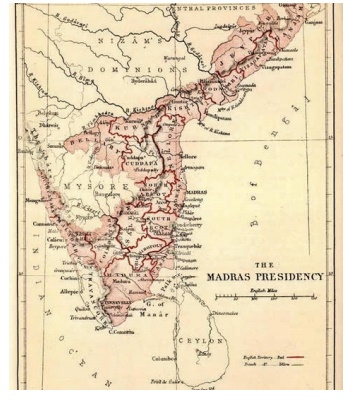Political History of Tamil Nadu
Compared with rest of India, Tamil Nadu has had a healthy administrative and political culture, more or less stable economic life, and continuity of traditions from the hoary past to the present. Madras Presidency of South India came into existence due to the administrative and political needs of the British. The Madras Presidency was formed in A.D (C.E.) 1801. The Presidency, as it existed during the 19th and 20th centuries, comprised of the present states of Andhra Pradesh, Malabar region of Kerala, Southern Karnataka, Southern most part of Odisha and Union Territory of Lakshadweep.

Madras Presidency politics in the early part of 20th century was dominated by the “Brahmin – non – Brahmin conflicts”. Scholars and political thinkers believed that understanding the conflicts between these two groups, (the Brahmins and non – Brahmins), is necessary to understand the South Indian Politics and society.
Madras Presidency
Simultaneously a few members of Non-Brahmin caste groups sought employment in industries, commercial enterprises etc., Significant but a portion of non-Brahmin caste groups migrated from rural areas to urban pockets of the Presidency and wanted to ascertain their identity as ‘Dravidian’ and ‘Tamils’ and gradually challenged the monopoly of powers and privileges enjoyed by the Brahmins in politics, administration and society.

The word ‘Dravidian’ was used by scholars and non – Tamils to identify non-Aryan Tamil speaking people. At the same time Brahmins were identified as “Aryans” and the custodians of Sanskrit civilisation where as non-Brahmins were considered as “Dravidians” and the custodians of Tamil language, culture and civilisation.














